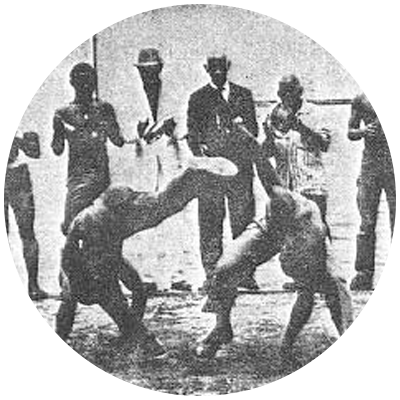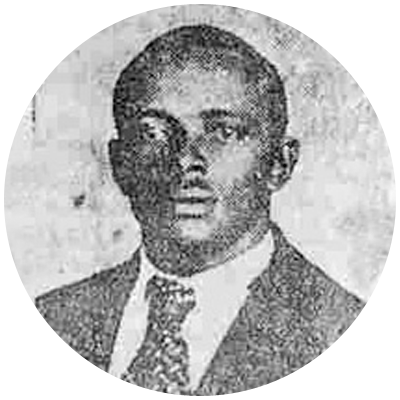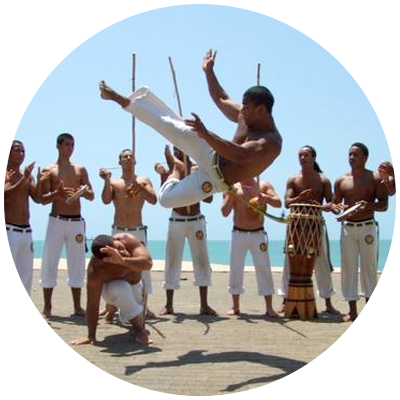What Is Capoeira?

Capoeira is an Afro-Brazilian martial art developed in the 1500s by African and Indigenous slaves in Brazil as a form of self-defence from their oppressors. It is marked by its agile and tricky movements that may be executed anywhere from an upside-down position, to a gravity defying kick. It has a strong acrobatic component in some styles and is always played with music. The word Capoeira is an indiginous word meaning ‘tall grass’. If slaves managed to escape, they would often use this grass to hide in and ambush their masters.
There are two main styles of Capoeira, along with many other less distinct ones. One is called Angola, which is characterized by tricky, low play with particular attention to the rituals and tradition of Capoeira. This style is often described as slow, however, may be just as fast as the next style, but with different rituals. The other style is Regional, known for its fluid acrobatic, high-flying kicks and powerful attacks. Speed and agility are common traits of this style. Both styles of Capoeira are marked by counter attacks, feints, and use lots of ground movements along with elbows, hands, kicks, head-butts,sweep and other take-downs.
History of Capoeira


Subsequently, The homogenization of the African people under the oppression of slavery was the catalyst for Capoeira. Capoeira was developed by the slaves of Brazil as a way to resist their oppressors, secretly practice their art, transmit their culture, and lift their spirits. There is also substantial evidence that indigenous peoples of Brazil played an important role in the development of Capoeira. Batuque and Maculele are other fight-dances closely connected to Capoeira.After slavery was abolished, the slaves moved to the cities of Brazil, and with no employment to be found, many joined or formed criminal gangs. They continued to practice Capoeira, and it became associated with anti-government or criminal activities. As a result, Capoeira was outlawed in Brazil in 1892. The punishment for practicing Capoeira was extreme, and the police were vicious in their attempt to stamp out the art. Capoeira continued to be practiced, but it moved further underground. Rodas were often held in areas with plenty of escape routes, and a special rhythm called Cavalaria was added to the music to warn players that the police were coming. To avoid being persecuted, Capoeira practitioners (Capoeiristas) also gave themselves an apelido or nicknames, often more than one. This made it much harder for the police to discover their true identities. This tradition continues to this day. When a person is baptized into Capoeira at the batizado ceremony, they may be given their apelido. In 1937, Mestre Bimba was invited to demonstrate his art in front of the president. After this performance, Capoeira became legally tolerated, and in 1953 it was completely legalized. Mestre Bimba is a critical historical figure for capoeira for many reasons, including being the person to open the first official Capoeira school in Brazil. Since 2008, Capoeira has been officially recognized as a national sport, and has spread around the world. Mestre Bimba’s systematization and teaching of capoeira made a tremendous contribution to the capoeira community.
In 1942, Mestre Pastinha opened the first Capoeira Angola school, the Centro Esportivo de Capoeira Angola, located in Bahia. He had his students wear black pants and yellow t-shirts, the same color of the “Ypiranga Futebol Clube,” his favorite soccer team. Most Angola schools since then follow in this tradition, having their students wear yellow capoeira t-shirts. Together, Mestre Bimba and Mestre Pastinha are generally seen as the fathers of modern Capoeira Regional and Capoeira Angola respectively.
Capoeira Music

There are three basic kinds of songs in Capoeira. ladainhas (litany), which are narrative solo songs, usually sung at the beginning of a roda, often by the Mestre (a teacher). These ladainhas will often be famous songs previously written by a Mestre, or they may be improvised on the spot. Quadras, which are another form of narrative song that are broken down into into multiple verses.thirdly, corridos, which are songs that are sung while a game is being played, following the call and response pattern. The responses to each call do not simply repeat what was said,however, but change depending on the song. The instruments are played in a row called the bateria. The first three instruments are Berimbaus, which look like an archer’s bow using a steel string and a gourd for resonation. These three Berimbaus are the Gunga (also called the Berraboi), Medio, & Viola (or violinha), and lead the rhythm. Other instruments in the bateria are: Pandeiro (tambourines), and the Atabaque (conga-like drum). Sometimes an Agogo (cowbells) and a Reco-reco (rasp) are used, particularly in the Angola style of Capoeira.
Capoeira Today


If you join a Axé Capoeira , you may eventually have a chance to take place in a batizado, a baptism into the art of Capoeira. At this point, you will normally be given a ‘corda’, a cord belt, as well as your ‘apelido’ or Capoeira nickname. Batizados are great celebrations of Capoeira, and normally a number of groups and masters from nearby or far away areas are invited to the celebration. These ceremonies are a great chance to see a variety of different Capoeira styles, to watch Mestres play, and to see some of the best of the game. these celebrations are open to the public, and they are a great chance for outsiders to learn about the art.




